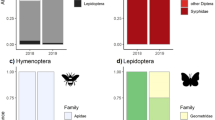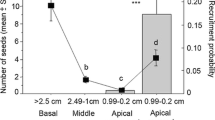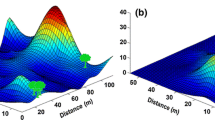Abstract
Different interactions occur simultaneously, affecting the ecological and evolutionary outcome of the species within a community. Mutualisms are particularly relevant for maintaining and generating biodiversity, and among them, pollination and seed dispersal play a central role in plant regeneration. Due to its parasitic life-form and ecological specialization, mistletoes provide a good study system to assess the effects of simultaneous interactions in the wild. We used the highly specialized mistletoe Tristerix aphyllus, its pollinator (the hummingbird Sephanoides sephaniodes), and its seed disperser (the mockingbird Mimus thenca) to assess their daily activity patterns during a flowering-fruiting overlap period. Given that both bird species are diurnal, we expect them to have different visitation times despite using different resources. Using camera traps, we found that both species have different daily activity patterns (overlap index \({\widehat{\Delta }}_{4}\) = 0.83, p < 0.001). While M. thenca had a narrow activity period early in the morning, S. sephaniodes had a wider activity range. We also found that the temporal variation of those activity patterns might be related to resource availability, as the number of flowers has decreased (F2,52 = 13.85, p < 0.001) over time, while the number of ripe fruits has increased (F2,52 = 5.16, p = 0.009) over time. Our results show that having different activity patterns could be a coexistence mechanism among bird species interacting with the same plant but exploiting different resources. Thus, taking activity patterns into account can provide a better understanding of ecological processes involving multiple interactions taking place simultaneously in the community.




Similar content being viewed by others
Data Availability
Figshare digital repository: https://doi.org/10.6084/m9.figshare.13607279
Code availability
Not applicable.
References
Acosta, I., Cabanne, G. S., Noll, D., González-Acuña, D., Pliscoff, P., & Vianna, J. A. (2020). Patagonian glacial effects on the endemic Green-backed Firecrown, Sephanoides sephaniodes (Aves: Trochilidae): Evidence from species distribution models and molecular data. Journal of Ornithology. https://doi.org/10.1007/s10336-020-01822-4
Aizen, M. A. (2003). Influences of animal pollination and seed dispersal on winter flowering in a temperate mistletoe. Ecology, 84, 2613–2627. https://doi.org/10.1890/02-0521
Arruda, R., Fadini, R. F., Carvalho, L. N., Del-Claro, K., Mourão, F. A., Jacobi, C. M., Teodoro, G. S., van den Berg, E., Caires, C. S., & Dettke, G. A. (2012). Ecology of neotropical mistletoes: An important canopy-dwelling component of Brazilian ecosystems. Acta Botânica Brasílica, 26, 264–274. https://doi.org/10.1590/S0102-33062012000200003
Bascompte, J. (2019). Mutualism and biodiversity. Current Biology, 29, R467–R470. https://doi.org/10.1016/j.cub.2019.03.062
Bascompte, J., & Jordano, P. (2007). Plant-animal mutualistic networks: The architecture of biodiversity. Annual Review of Ecology Evolution and Systematics, 38, 567–593. https://doi.org/10.1146/annurev.ecolsys.38.091206.095818
Bascompte, J., Jordano, P., Melian, C. J., & Olesen, J. M. (2003). The nested assembly of plant-animal mutualistic networks. Proceedings of the National Academy of Sciences USA, 100, 9383–9387. https://doi.org/10.1073/pnas.1633576100
Bascompte, J., Jordano, P., & Olesen, J. M. (2006). Asymmetric coevolutionary networks facilitate biodiversity maintenance. Science, 312, 431–433. https://doi.org/10.1126/science.1123412
Burton, A. C., Neilson, E., Moreira, D., Ladle, A., Steenweg, R., Fisher, J. T., Bayne, E., & Boutin, S. (2015). Wildlife camera trapping: a review and recommendations for linking surveys to ecological processes. Journal of Applied Ecology, 52, 675–685. https://doi.org/10.1111/1365-2664.12432
Ewald, P. W. (1985). Influence of asymmetries in resource quality and age on aggression and dominance in Black-Chinned hummingbirds. Animal Behaviour, 33, 705–719. https://doi.org/10.1016/S0003-3472(85)80001-4
Fadini, R. F., Fischer, E., Castro, S. J., Araujo, A. C., Ornelas, J. F., & de Souza, P. R. (2018). Bat and bee pollination in Psittacanthus mistletoes, a genus regarded as exclusively hummingbird-pollinated. Ecology, 99, 1239–1241. https://doi.org/10.1002/ecy.2140
Fontúrbel, F. E. (2020). Mistletoes in a changing world: A premonition of a non-analog future? Botany, 98, 479–488. https://doi.org/10.1139/cjb-2019-0195
Fontúrbel, F. E., Jordano, P., & Medel, R. (2015). Scale-dependent responses of pollination and seed dispersal mutualisms in a habitat transformation scenario. Journal of Ecology, 103, 1334–1343. https://doi.org/10.1111/1365-2745.12443
Fontúrbel, F. E., Orellana, J. I., Rodríguez-Gómez, G. B., Tabilo, C. A., & Castaño-Villa, G. J. (2021). Habitat disturbance can alter forest understory bird activity patterns: A regional-scale assessment with camera-traps. Forest Ecol Manag, 479, 118618. https://doi.org/10.1016/j.foreco.2020.118618
Fontúrbel, F. E., Salazar, D. A., & Medel, R. (2017). Increased resource availability prevents the disruption of key ecological interactions in disturbed habitats. Ecosphere, 8, e01768. https://doi.org/10.1002/ecs2.1768
González-Gómez, P. L., Madrid-Lopez, N., Salazar, J. E., Suárez, R., Razeto-Barry, P., Mpodozis, J., Bozinovic, F., & Vásquez, R. A. (2014). Cognitive ecology in hummingbirds: The role of sexual dimorphism and its anatomical correlates on memory. PLoS ONE, 9, e90165. https://doi.org/10.1371/journal.pone.0090165
González-Gómez, P. L., Ricote-Martinez, N., Razeto-Barry, P., Cotoras, I. S., & Bozinovic, F. (2011). Thermoregulatory cost affects territorial behavior in hummingbirds: A model and its application. Behavioral Ecology and Sociobiology, 65, 2141–2148. https://doi.org/10.1007/s00265-011-1222-2
González-Gómez, P. L., & Vásquez, R. A. (2006). A field study of spatial memory in Green-Backed Firecrown hummingbirds (Sephanoides sephaniodes). Ethology, 112, 790–795. https://doi.org/10.1111/j.1439-0310.2006.01223.x
González-Gómez, P. L., Vasquez, R. A., & Bozinovic, F. (2011). Flexibility of foraging behavior in hummingbirds: The role of energy constraints and cognitive abilities. The Auk, 128, 36–42. https://doi.org/10.1525/auk.2011.10024
Guerra, T. J., & Pizo, M. A. (2014). Asymmetrical dependence between a Neotropical mistletoe and its avian seed disperser. Biotropica, 46, 285–293. https://doi.org/10.1111/btp.12112
Jaksic, F. M. (2001). Ecological effects of El Nino in terrestrial ecosystems of western South America. Ecography, 24, 241–250. https://doi.org/10.1034/j.1600-0587.2001.240301.x
Lucero, F., Botto-Mahan, C., Medel, R., & Fonturbel, F. E. (2014). New insights on the mistletoe Tristerix aphyllus (Loranthaceae): interaction with diurnal and nocturnal frugivorous species. Gayana Bot, 71, 270–272. https://doi.org/10.4067/S0717-66432014000200010
Martínez del Río, C., Silva, A., Medel, R., & Hourdequin, M. (1996). Seed dispersers as disease vectors: Bird transmission of mistletoe seeds to plant hosts. Ecology, 77, 912–921. https://doi.org/10.2307/2265511
Medel, R. (2000). Assessment of parasite-mediated selection in a host-parasite system in plants. Ecology, 81, 1554–1564. https://doi.org/10.1890/0012-9658(2000)081[1554:AOPMSI]2.0.CO;2
Medel, R., Botto-Mahan, C., Smith-Ramirez, C., Mendez, M. A., Ossa, C. G., Caputo, L. N., & Gonzales, W. L. (2002). Quantitative natural history of a host-parasite relationship: The Tristerix-cactus system in semiarid Chile. Revista Chilena De Historia Natural, 75, 127–140.
Medel, R., Vergara, E., Silva, A., & Arroyo, M. K. (2004). Effects of vector behavior and host resistance on mistletoe aggregation. Ecology, 85, 120–126. https://doi.org/10.1890/03-0261
Pavan, L. I., Jankowski, J. E., & Hazlehurst, J. A. (2020). Patterns of territorial space use by Shining Sunbeams (Aglaeactis cupripennis), tropical montane hummingbirds. Journal of Field Ornithology, 91, 1–12. https://doi.org/10.1111/jofo.12321
R Development Core Team (2020). R: A language and environment for statistical computing, reference index version 3.6.3. Foundation for Statistical Computing, Vienna, Austria
Reid, S., & Armesto, J. J. (2011). Interaction dynamics of avian frugivores and plants in a Chilean Mediterranean shrubland. Journal of Arid Environments, 75, 221–230. https://doi.org/10.1016/j.jaridenv.2010.10.002
Ridout, M. S., & Linkie, M. (2009). Estimating overlap of daily activity patterns from camera trap data. Journal of Agricultural, Biological, and Environmental Statistics, 14, 322–337. https://doi.org/10.1198/Jabes.2009.08038
Rodríguez-Gómez, G. B., & Fontúrbel, F. E. (2020). Regional-scale variation on Dromiciops gliroides occurrence, abundance, and activity patterns along a habitat disturbance gradient. Journal of Mammalogy, 101, 733–741. https://doi.org/10.1093/jmammal/gyaa022
Rosenberg, M. S., & Anderson, C. D. (2011). PASSaGE: Pattern Analysis, Spatial Statistics and Geographic Exegesis. Version 2. Methods in Ecology and Evolution, 2, 229–232. https://doi.org/10.1111/j.2041-210X.2010.00081.x
Rowcliffe, J. M., Kays, R., Kranstauber, B., Carbone, C., & Jansen, P. A. (2014). Quantifying levels of animal activity using camera trap data. Methods in Ecology and Evolution, 5, 1170–1179. https://doi.org/10.1111/2041-210x.12278
Rowcliffe M (2019). Activity: Animal Activity Statistics. R package version 1.2. https://CRAN.R-project.org/package=activity
Schupp, E. W., Jordano, P., & Gómez, J. M. (2017). A general framework for effectiveness concepts in mutualisms. Ecology Letters, 20, 577–590. https://doi.org/10.1111/ele.12764
Strauss, S. Y., & Irwin, R. E. (2004). Ecological and evolutionary consequences of multispecies plant-animal interactions. Annual Review of Ecology Evolution and Systematics, 35, 435–466. https://doi.org/10.1146/annurev.ecolsys.35.112202.130215
Vazquez, D. P., & Aizen, M. A. (2004). Asymmetric specialization: A pervasive feature of plant-pollinator interactions. Ecology, 85, 1251–1257. https://doi.org/10.1890/03-3112
Watson, D. M. (2001). Mistletoe—A keystone resource in forests and woodlands worldwide. Annual Review of Ecology and Systematics, 32, 219–249. https://doi.org/10.1146/annurev.ecolsys.32.081501.114024
Watson, D. M. (2004). Mistletoe: A unique constituent of canopies worldwide. In M. D. Lowman & H. B. Rinker (Eds.), Forest Canopies (2nd ed., pp. 212–223). Academic Press.
Watson, D. M. (2013). The relative contribution of specialists and generalists to mistletoe dispersal: Insights from a Neotropical rain forest. Biotropica, 45, 195–202. https://doi.org/10.1111/j.1744-7429.2012.00905.x
Watson, D. M., & Rawsthorne, J. (2013). Mistletoe specialist frugivores: Latterday “Johnny Appleseeds” or self-serving market gardeners? Oecologia, 172, 925–932. https://doi.org/10.1007/s00442-013-2693-9
Wolf, C., & Hagen, E. (2012). Aggressive interactions of firecrowns (Sephanoides spp.; Trochilidae) during the breeding season on Robinson Crusoe Island, Chile. Ornitologia Neotropical, 23, 545–553.
Acknowledgements
R. Cares, P. Cares, N. Peña, and F. Lucero assisted in the field. F. Lucero assisted with the raw camera-trap data processing. R. Medel and C. Botto arranged the 2013 fieldwork with funding of the FONDECYT projects 11090086 and 1120155, who authorized the reuse of raw camera trap data for this study. Comments from two anonymous reviewers helped us to improve the manuscript. Camera traps used were previously acquired with resources from the Rufford Foundation (Grant 10621-1 to FEF). The Chilean Forestry Corporation (CONAF) authorized access to the study site and provided lodging facilities.
Funding
No funding was received to assist with the preparation of this manuscript.
Author information
Authors and Affiliations
Contributions
FEF conceived the ideas and designed the methodology. FEF collected field data. VF processed field data. VF and FEF analyzed data. VF led manuscript writing with contributions of FEF.
Corresponding author
Ethics declarations
Conflicts of interest
The authors have no relevant financial or nonfinancial interests to disclose.
Ethics approval
Not applicable.
Consent to participate
Not applicable.
Supplementary Information
Below is the link to the electronic supplementary material.
Rights and permissions
About this article
Cite this article
Fernández, V.P., Fontúrbel, F.E. Temporal variation of daily activity on pollinator and frugivorous birds simultaneously interacting with a specialized mistletoe. COMMUNITY ECOLOGY 22, 217–223 (2021). https://doi.org/10.1007/s42974-021-00050-x
Received:
Accepted:
Published:
Issue Date:
DOI: https://doi.org/10.1007/s42974-021-00050-x




